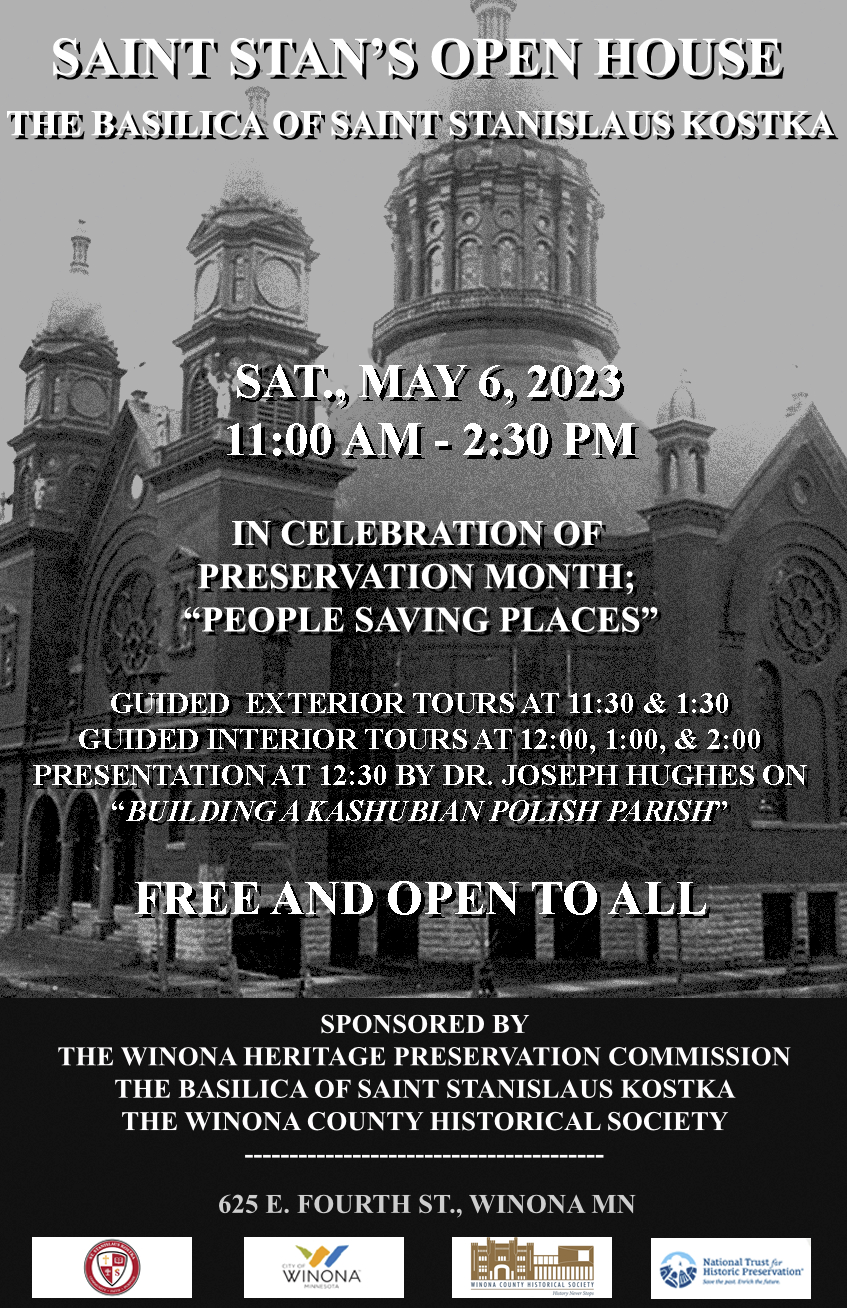St. Stanislaus Kostka Basilica Open House Event

Saturday | May 6 | 11 am-2:30 pm
Basilica of St. Stanislaus Kostka | 625 E Fourth St.
In honor of Preservation Month the City of Winona’s Heritage Preservation Commission (HPC) is co-sponsoring an Open House at the Basilica of St. Stanislaus Kostka on Saturday, May 6th, 2023 from 11:00 A.M. to 2:30 P.M. The event’s other sponsors are the Basilica of St. Stanislaus Kostka (BSSK) and the Winona County Historical Society. Preservation Month activities are promoted each May by the National Trust for Historic Preservation to celebrate the country’s architectural treasures. This year’s theme is “People Saving Places.”
The Open House is free to the public.
Two brief guided tours of the Basilica’s exterior—at 11:30 A.M. and 1:30 P.M.—will be conducted by Luke Sims, Winona’s City Planner and staff liaison to the HPC. Three guided tours of the Basilica’s interior—at noon, 1:00 and 2:00 P.M.—will be conducted by Justin Green, Deacon, BSSK. A short video consisting of aerial footage and photos of the Basilica produced by Bill Kuhl will be screened continuously in the vestibule.
At 12:30 P.M., in the Basilica’s lower level, a talk entitled “Building a Kashubian Polish Parish” about BSSK’s congregational history will be delivered by Dr. Joseph Hughes, Professor Emeritus of Classics, Missouri State University. HPC Chair Emily Kurash Casey will present the 2023 Preservation Month Award to Adam J. Cloeter of River Vista Properties, LLC in recognition of his several historic preservation projects in Winona’s downtown commercial district.
St. Stanislaus Kostka Church was designed by the local architectural firm of Charles G. Maybury and Son, who also designed the Winona County Courthouse among other local landmarks. It was erected in 1895 with labor supplied by Winona stone masons, bricklayers, and carpenters and was placed on the National Register of Historic Places in 1984. The Vatican designated it a Minor Basilica in 2011.
According to architectural historian Robert M. Frame III, the Church is built on a Greek cross plan, being 140 ft. from north (the main entrance and vestibule) to south (the sanctuary) and 124 ft. from east to west. The red pressed-brick structure rests on a stone foundation. Frame notes that a late 19th-century source identifies “the style of architecture [as] Roman, with classic detail,” while a more recent description calls St. Stanislaus “a remarkable blending of the Baroque and the Romanesque.” The interior space was designed to accommodate 1,400 worshippers on the main floor and an additional 400 in the gallery.
St. Stanislaus Kostka Catholic Church is inextricably associated with Winona’s Polish community which, by 1905, constituted the largest concentration of Poles in Minnesota. Frame observes that “historically, Poles and Germans were Winona’s most prominent ethnic groups. Polish people first came to Winona in 1855 and most Poles settling in the city were Kashubians, from an area under Prussian and German rule. In Winona, they became members of St. Joseph’s, a German-language parish. In 1871 they established a Polish parish in honor of St. Stanislaus Kostka, completing a 600 capacity church the following year, on the site of the present church. With a growing membership, the parish needed a new church, and in 1894 razed the 1872 building to erect the present structure … which was completed in 1895. Much of the money for construction was raised by forming the Polish Catholic Church Building Company which sold interest-bearing stock to members of the Polish community.” Frame concludes that St. Stan’s, as it is fondly known, “testifies to the strong desire of the Winona Polish community to use their moderate resources to produce a large and striking edifice that would demonstrate their sense of importance in the city.”
The Basilica of St. Stanislaus Kostka fosters local pride, attracting visitors from far and wide to appreciate its singular beauty. Winona’s Heritage Preservation Commission was created by the city council in 1989 to serve as stewards and champions of our community’s distinctive historic architecture. Come see for yourself on May 6th how the Basilica epitomizes this year’s Preservation Month theme of “People Saving Places.”
Heritage Preservation Commission Vice Chair Michael William Doyle and the Winona County Historical Society are members of the River Arts Alliance. To learn more about the benefits of membership, please visit: riverartsalliance.org/membership/.
